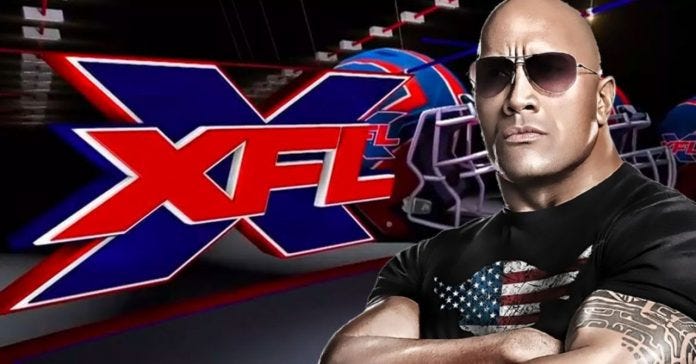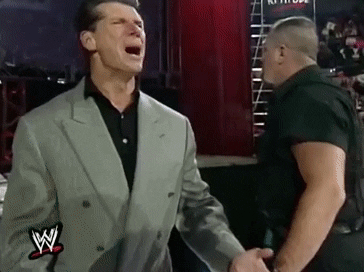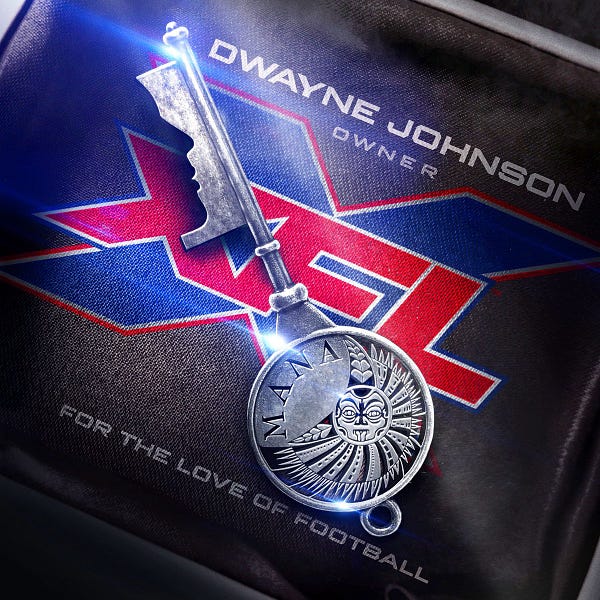XFL, Distressed M&A, and Celebrity Investors 🏈
The Rock, Dany Garcia, and RedBird Captial team up to buy XFL parent (Alpha Entertainment); #ForTheLoveOfUnsecuredCreditors
Reminder: this newsletter is free, I sustain exclusively on s̶t̶u̶d̶e̶n̶t̶ ̶d̶e̶b̶t̶ the ego boost provided by each new subscriber. So if you know someone who’d love to get Lever Up in their inbox (or has been involved with the subject of discussion), I encourage you to forward this to them!
Follow me on Twitter for programming updates at @_LeverUp. You can also reply to this email with praise, hatemail, or scoop for the next post.
I remain skeptical of adding a “Subscribe now” button to an email that you received after already subscribing. Still, newsletter best practices suggest I should have it front and center at the top of my post in case you were forwarded this from a friend or a colleague. Et voila:
Now I’m just pandering. Not only because the target is a football league being purchased by celebrity investors, but also because it touches on two trending topics that have been garnering attention among private equity investors and FinTwit alike — bankruptcy sales and microcap PE. Interest in bankruptcy sales generally ticks up during an economic slowdown, but micro PE something that has been gaining momentum over the recent decades, and I expect will continue to do so. Search funds, lower middle market PE funds, independent sponsors, and (select) family offices have all been acquiring businesses in the sub-$5M EBITDA space. Arguably, this space is already very saturated (speaking with some peers, it’s been more difficult to bid competitively for sub-$100M deals than deals in the $100-300M range, though I am skeptical this holds on an aggregate basis; obviously, multiples are higher at the larger deal size (all else equal), but it may have to do with the bidders having greater comfort with proven scalability of more substantial businesses); nonetheless, it continues to generate interest from both experienced investors and operators seeking to acquire a job for themselves.
Target 🎯

(Image via PWMania)
Vince McMahon, of the WWE fame, officially announced his intent to reignite XFL in 2018, seventeen years after the first iteration of the league was founded. (The parent company of XFL, the one going through the bankruptcy process, is Alpha Entertainment LLC, but for simplicity, I’ll be referring to the business as XFL throughout this post.) Although the 2001 start proved unsuccessful, and NBC (its co-sponsor) withdrew from the venture, the new-and-improved XFL was mostly well-received by fans and commentators alike. With NFL battling never-ending controversies (political, social, gameplay, player conduct, and more gameplay), XFL was ready to offer fans faster-paced football, better access to coaches, and a friendlier attitude to experimenting with the rules. McMahon owns all of the Class A shares, and approximately 74% of Class B shares, with the remainder owned by WWE (which is itself ~controlled by McMahon).
In January 2019, XFL recruited Jeffrey Pollack as the President and COO of XFL to oversee the league’s business operations and lead strategic planning. Pollack spent his career running World Series of Poker before transitioning to sports marketing roles and was responsible for negotiating some key partnerships for both WSOP and other employers. After a false start trying to launch Epic Poker League, he spent a few years consulting for the LA Chargers.
According to the docket, XFL generated ~$20M revenue through April 2020, before it filed for bankruptcy. Pollack’s declaration details that in the first three weeks of play, the league generated $44M of net losses on $14M of revenue. Patrick Rishe over at Forbes estimates the pandemic cost the league approximately $27M over the rest of the season. Not exactly what one would call a cash cow, but a solid start for a newly-formed league.
Once COVID-19 pandemic hit and games had to be stopped, McMahon extended a $9M senior secured loan to XFL. Ultimately the league could not avoid the inevitable, and XFL filed for bankruptcy protection on April 13, 2020. Petition discussed XFL’s bankruptcy proceedings in April, as the process was starting to unravel. Among other things, the company sought to issue refunds to customers, and receive authorization for a $3.5M DIP facility (proposed by McMahon). Unsecured Creditors Committee were having none of it, asserting that XFL “has done little more than act as a shill for McMahon.” Speaking of the UCC, it really do be your own coaches sometimes.

Buyer 💰
McMahon initially sought to buy the company himself, but, given the objections by unsecured creditors to the DIP proposal and the suggested auction timeline, eventually backed out. But not before throwing some shade back at the UCC:
Filled to the brim with inflammatory rhetoric and unsubstantiated accusations that the Debtor rigged the Bidding Procedures in favor of Vince McMahon, the Committee’s Objection is irresponsible and value-destructive. Indeed, in response to the needlessly vitriolic personal attacks in the Committee’s Objection, McMahon has chosen to bid the Debtor good luck and simply walk away from any potential bid for the Debtor’s assets.
(I’m probably missing something, but I can’t figure out why a handful of sub-$1M creditors are so set against McMahon?)

The bankers (Houlihan Lokey) ran a marketing process, contacting over 246 potential buyers, of which 35 signed an NDA and received the CIM. Of those, four submitted IOIs and two submitted bids. Alpha Acquico LLC (Acquico), backed by Dwayne “The Rock” Johnson, Danny Garcia, and RedBird Capital Partners, was selected as the winning bidder. With Acquico submitting the only qualifying bid, the scheduled bankruptcy auction was canceled, and the judge approved the sale (despite creditors’ objections).
RidBird has been expanding its sports-related portfolio with acquisitions of YES Network (2019), OneTeam (2019), and RedBird FC (2020). It also owned a portion of NFL On Location, before selling that business to Endeavor for an estimated $660M (somewhere around low/mid-teens xEBITDA judging by the latest press). Bloomberg reports that RedBird’s investment in On Location was done at around $70M in 2015, which means that the firm made, in academic terms, a “shit ton of money” on that deal. Although Endeavor had been circling since 2018, surely Gerry Cardinale is ecstatic that the deal closed before COVID-19 pandemic disrupted sports/life.
Garcia, aside from being a film producer and a talent manager, also runs The Garcia Companies, a portfolio of consumer brands. Johnson and Garcia (previously married) have invested together in the past (in addition to Garcia managing The Rock and producing some of his movies). In 2019 they invested in Salt & Straw, a chain of artisanal ice cream shops (also backed by Union Square Hospitality Group).
Market 📓
It should come as no surprise that football is the most popular sport in America. Pollack’s First Day Declaration cites over 85 million fans, many of whom are itching for more football content than NFL and college football are able to supply.
In the context of a broader demand for sports, the NFL season ends around February, leaving a short gap before NBA March Madness begins. XFL season was intended to, partially, fill that gap, running from February through April.
Depending on who you ask, the overall sports market in North America is somewhere between $70B and $80B (pre-COVID), but what XFL was betting on wasn’t a macro play. The league sought to spice up NFL gameplay and coverage with, as Connor Orr put it, “a little weird. Weird kickoffs. Weird double passes. Weird quarterback substitution patterns. A little dose of imagination.”
Distressed M&A 101 (part I?) 🈹
What follows is a very rudimentary summary of the ways buyers can acquire a company in distress. If there’s interest in learning more, I may potentially expand on this in future posts. While the basic principals of acquiring a business in distress are generally the same as those of M&A (buy low, sell high; pitch yourself to the counterparty; pay advisor fees), there are important differences in the mechanics of the transactions. I don’t want to oversimplify this too much, but the key differences are essentially the definitions of what exactly is being acquired (specifically, which assets, and, perhaps more importantly, which liabilities are being transferred to the buyer).
One intuitive way I’ve heard this explained is thinking of the different mechanisms as wrappers on the underlying business. The different types of wrappers entail varying levels of risk to the buyer with regard to, among other things, the assumption of liabilities of the underlying business. Viewing it on a spectrum, one extreme is a purchase without any wrapper (e.g., purchasing the equity and assuming all liabilities and potential claims against the business), and the other extreme is a purchase under a Chapter 11 Plan. Listed in order of riskiest (to the buyer) to safest, the wrappers are:
No wrapper: traditional M&A, purchase of equity or assets
Article 9 sale: out of court, allows secured creditors to sell collateral without court intervention (more via DailyDAC)
Assignment for the Benefit of Creditors (ABC): out of court, a mechanism for acquiring distressed businesses ~free of unsecured debt (more via ABA)
Purchase through a Receivership: an alternative bankruptcy sales process, in or out of court (more via DailyDAC)
363 Sale (via Ch.7 or Ch.11): in court, generally an auction process, one of the more common mechanisms to sell a distressed business free and clear of claims (more via CFI)
Sale pursuant to Chapter 11 Plan: in court, a lengthier (more expensive) process than a 363 sale, but allows obtaining broader third-party releases (more via McDonald Hopkins)
As may be expected, transactions on the riskier side of the spectrum tend to be less competitive and potentially cheaper (at least initially). If you prefer slides to narrative, here’s a good distressed M&A primer from Mayer Brown.
A buyer would seek to minimize their exposure to claims against the business (whether from creditors, vendors, or potential lawsuits). A seller would want to part with the company and retain exactly zero of such exposure. To varying degrees, the wrappers discussed above provide the mechanics to execute such a transaction, while also preserving the rights of pre-petition creditors. In-court transactions also allow a potential buyer to cherry-pick favorable contracts and leases.
Another tool worth mentioning is “loan to own,” where a prospective buyer purchases the secured debt of a target company with the intent of influencing control or using their debt position as a credit bid in a 363 sale. An extension of this would be providing DIP financing to the company with the intent of the DIP loan in a credit bid. This is what UCC suspected was happening with McMahon’s proposed DIP to XFL. Speaking of XFL, for those of you still reading, let’s get back to talking about the deal.
Deal 🖋️
Announcement date: August 7, 2020 (latest terms)
Enterprise Value: $15M + some assumed contracts + up to $9M cure payments
<1.0x Revenue?
More likely the valuation was based on some blended basis of a DCF and “brand value”, considering XFL is not expected to generate profits in the near term (because of COVID-19, and (probably) because this is more of a growth-type investment where the buyers will likely funnel more money into expanding the franchise before flipping the proverbial profitability switch on)Acquisition Debt: No, obviously not. Sufficiently jaded by the industry, one can perhaps speculate whether one of the three parties (RedBird) structured their investment (in Acquico) at a higher liquidation preference to others, but there’s no way to know.
Acquico’s bid included consideration of (i) $15M, (ii) assumption of certain liabilities, and (iii) up to ~9M of cure payments. The bulk of the cure payments are merchant processing fees, stadium use and training expenses, and a handful of marketing/consulting agreements.
The initial Asset Purchase Agreement was submitted on July 30, and the UCC wasted no time before filing its objection, primarily relating to the treatment of causes of action (including claims against insiders, which UCC speculates may include over $60M potentially avoidable and recoverable transfers). (Worth noting that the unsecured creditors earlier expressed interest in converting the case to a Chapter 7 liquidation.)


Ultimately, XFL filed an updated APA on August 6, reflecting some of the modifications requested by the UCC. While many bankruptcies involve some level of confrontation between conflicting constituencies, this case gives off hints of UCC lawyers flooding the Debtor with “asks” for the sake of proving their worth to their clients. (If there was an overarching strategy beyond “see what sticks,” it clearly went way over my head.)
On August 21, The Rock tweeted that the sale has officially closed.


I don’t have a view one way or another (aka I haven’t seen the CIM), but I think $15M may be a reasonable flier to take on a shell of a football league which enjoyed some positive reception at launch. The market for football is there, and the NFL certainly gives off a stuffy vibe. I’m curious to what extent, if any, The Rock will leverage his personal brand in reigniting the XFL going forward.



